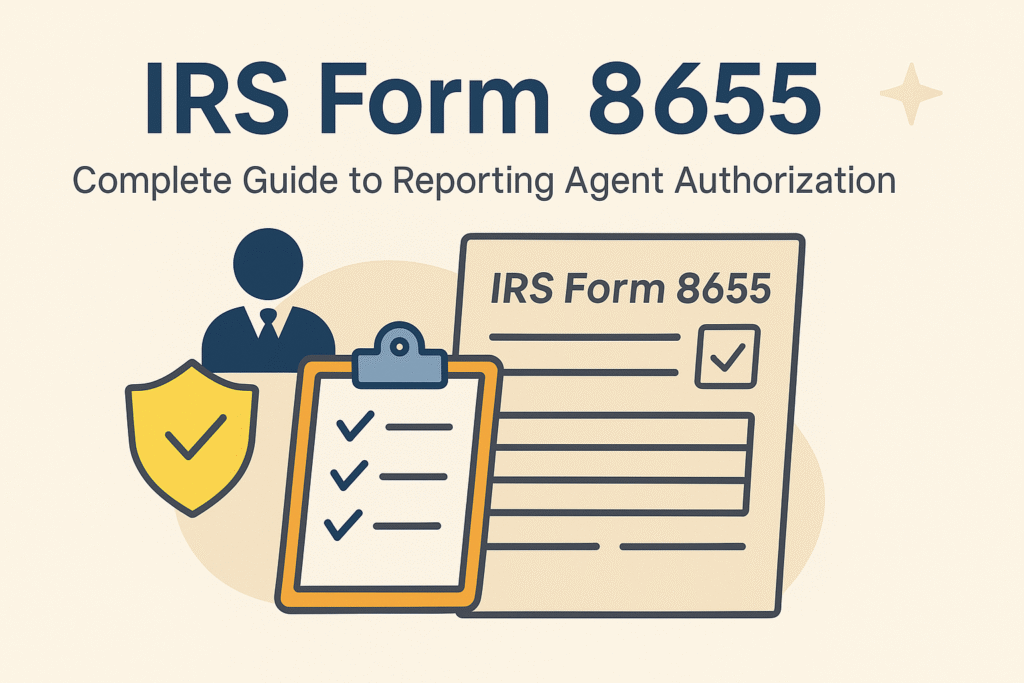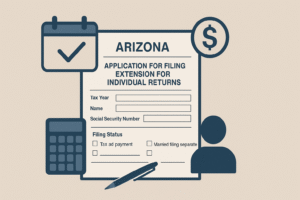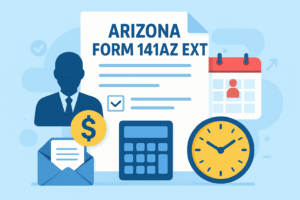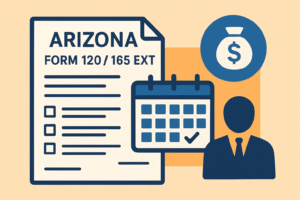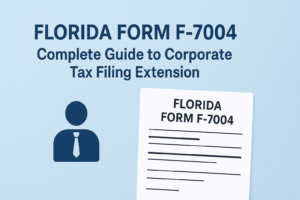Managing payroll taxes, filing returns, and staying compliant with IRS requirements can be time-consuming for businesses of all sizes. That’s where IRS Form 8655, Reporting Agent Authorization, comes into play.
This form allows a taxpayer to officially authorize a qualified third party—such as a payroll service provider, tax preparer, or accounting firm—to handle critical tax-related tasks on their behalf. From filing employment tax returns and making electronic tax payments to receiving IRS correspondence, Form 8655 helps streamline operations while keeping compliance in check.
In this guide, we’ll cover everything you need to know about Form 8655, including its purpose, who can use it, detailed line-by-line completion instructions, and how to file it correctly.
What is the purpose of Form 8655?
Form 8655, officially titled Reporting Agent Authorization, is used by a taxpayer to give a third party—known as a reporting agent—the legal authority to handle specific tax-related responsibilities on their behalf.
These responsibilities may include:
- Signing and electronically filing certain employment and information tax returns.
- Making federal tax deposits and payments through the Electronic Federal Tax Payment System (EFTPS).
- Receiving duplicate copies of IRS notices, correspondence, and other communications.
- Providing tax-related information to the IRS to help determine whether penalty relief is warranted.
The purpose of this form is to streamline tax compliance for businesses and organizations by allowing a qualified third party—often a payroll company, accounting firm, or tax service provider—to manage routine but critical tax obligations. However, the taxpayer remains legally responsible for the accuracy of filings and for making timely payments, even after granting this authorization.
Who needs to file Form 8655?
Filing Form 8655 is necessary when:
- A taxpayer hires a payroll service provider or tax filing company to prepare and e-file employment tax returns.
- A business authorizes a bank or payroll processor to make EFTPS tax payments.
- An organization wants its reporting agent to receive duplicate IRS notices to handle compliance issues proactively.
Who can authorize the reporting agent using Form 8655?
The authority to sign and submit Form 8655 rests with someone legally allowed to bind the taxpayer. This depends on the taxpayer’s legal entity type:
- Sole Proprietorship – The individual owner must sign.
- Corporation or LLC taxed as a corporation – An officer of the company, a duly authorized board representative, or a person granted authority under the Internal Revenue Code.
- Partnership or LLC taxed as a partnership – Any partner who was actively involved during the tax period covered.
- Single-Member LLC (disregarded entity) – The sole owner of the LLC.
- Trust or Estate – The fiduciary, such as the trustee or executor, who manages the trust or estate’s affairs.
This ensures that only an authorized decision-maker, with the legal capacity to represent the taxpayer entity, can appoint a reporting agent.
What Are the Forms That Can Give Authorization Using Form 8655?
The form separates permissions into categories, so you can grant authority for tax return filing, federal tax deposits/payments, responding to notices, and related state/local filings.
Below is a breakdown of the forms that can be authorized under each category.
1. Tax Filing Authorization
This section of Form 8655 allows the reporting agent to electronically file specific IRS tax returns on behalf of the taxpayer. You may select only the forms you want them to handle. Common authorized forms include:
- Form 940 – Employer’s Annual Federal Unemployment (FUTA) Tax Return
- Form 941 – Employer’s Quarterly Federal Tax Return
- Form 943 – Employer’s Annual Federal Tax Return for Agricultural Employees
- Form 944 – Employer’s Annual Federal Tax Return (for eligible small employers)
- Form 945 – Annual Return of Withheld Federal Income Tax
- Form 1042 – Annual Withholding Tax Return for U.S. Source Income of Foreign Persons
- Form CT-1 – Employer’s Annual Railroad Retirement Tax Return
2. Tax Deposit and Payment Authorization
This section allows the reporting agent to make federal tax deposits and payments on the taxpayer’s behalf through the Electronic Federal Tax Payment System (EFTPS). You can authorize any combination of these forms:
- Form 940 – FUTA tax deposits
- Form 941 – Payroll tax deposits
- Form 943 – Agricultural payroll tax deposits
- Form 944 – Annual payroll tax deposits for small employers
- Form 945 – Withheld federal income tax deposits
- Form 1042 – Withholding tax deposits for foreign income
- Form CT-1 – Railroad Retirement tax deposits
- Form 990-PF – Private Foundation Excise Tax Return deposits
- Form 990-T – Exempt Organization Business Income Tax Return deposits
- Form 720 – Quarterly Federal Excise Tax Return deposits
- Form 1041 – U.S. Income Tax Return for Estates and Trusts deposits
- Form 1120 – U.S. Corporation Income Tax Return deposits
3. Authorization to Respond to IRS Notices
This section allows the reporting agent to receive and respond to certain IRS notices, correspondence, or inquiries related to the taxpayer’s account. Commonly authorized forms include:
- Form W-2 – Wage and Tax Statement
- Form 1099 – Information returns (various types)
- Form 3921 / 3922 – Stock option and employee stock purchase plan reporting
4. Authorization for State and Local Returns
Form 8655 can also authorize the reporting agent to prepare, file, and make deposits/payments for related state and local returns that correspond to the federal forms listed in the Tax Filing and Tax Deposit sections. This allows a single agent to handle compliance at all levels of government, streamlining the employer’s reporting process.
Key point: You don’t have to authorize all forms in all categories—you can pick and choose based on the scope of services you want your reporting agent to handle. This flexibility helps business owners retain control over certain tax functions while outsourcing others.
Note: Once a client authorizes a reporting agent by signing IRS Form 8655, Reporting Agent Authorization, the agent is generally required to file tax returns and make tax deposits electronically on the client’s behalf. This requirement aligns with the IRS’s e-file mandate, which helps ensure faster processing, fewer errors, and better compliance tracking.
How to complete Form 8655? (Line-by-line instructions)
Here is a detailed breakdown of the form’s sections:
Lines 1–5:
- Enter the taxpayer’s legal name, trade name (if any), Employer Identification Number (EIN), address, and check the box if the business is seasonal.
Lines 6–8:
- Provide the name, title, and contact information of the taxpayer’s contact person. Include phone and fax numbers.
Lines 9–14:
- Enter the reporting agent’s legal name, EIN, address, and contact information.
Line 15:
- Specify the tax returns the agent is authorized to file. Use the correct date format: YYYY/MM for quarterly returns and YYYY for annual returns.
Example: For the third quarter of 2025, enter “2025/09.”
Line 16:
- Indicate the tax returns for which the reporting agent can make deposits and payments, using the same date format.
Line 17:
- Check this box if the reporting agent should receive duplicate IRS correspondence.
Lines 18a–18c:
- Authorize the agent to prepare and file Forms W-2, 1099, or Forms 3921/3922 by entering the starting calendar year.
Line 19:
- Optionally authorize the reporting agent to file state and local returns related to the federal returns listed.
Signature block:
- The authorized person must sign, date, and enter their title. This signature certifies that the signer has the legal authority to grant the authorization.
How to file Form 8655
Once completed and signed, Form 8655 can be filed with the IRS in one of two ways:
- By Mail – Send the form to the IRS Accounts Management Service Center in Ogden, Utah.
- By Fax – Preferred for speed. Fax the form to the designated IRS fax number. Up to 25 forms can be faxed in a single batch.
For reporting agents handling multiple clients, a Reporting Agent’s List must also be submitted, showing all taxpayers granting authorization.
Where to mail Form 8655
If mailing, send the completed form to:
Internal Revenue Service
Accounts Management Service Center
MS 6748 RAF Team
1973 North Rulon White Blvd.
Ogden, UT 84404
If faxing, use the official IRS fax number 855-214-7523 for Form 8655 submissions.
How long is Form 8655 valid for?
The authorization becomes effective once the IRS processes the signed form and the specified start period begins. It remains in effect indefinitely until:
- A new Form 8655 is submitted with updated information.
- The taxpayer sends a signed written statement to revoke the authorization.
- A copy of the original form marked “REVOKE” is sent to the IRS.
This ongoing validity allows the reporting agent to act continuously until the taxpayer actively ends the arrangement.
Final Thoughts
Form 8655 is a powerful tool for streamlining tax compliance by delegating filing and payment responsibilities to trusted third parties. It can save time, reduce administrative burden, and ensure timely compliance with IRS requirements. However, granting this authority does not transfer legal responsibility—taxpayers remain accountable for accurate and timely filings.
For best results, taxpayers should:
- Choose reputable reporting agents.
- Clearly understand the scope of authority granted.
- Keep copies of all filed authorizations and revocations.

